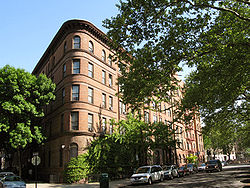Harlem, Manhattan
| Harlem | |
|---|---|
| Neighborhood of Manhattan | |

Stately Harlem apartment buildings adjacent to Morningside Park
|
|
| Nickname(s): "Heaven", "Black mecca" | |
| Motto: "Making It!" | |
| Country |
|
| State |
|
| County | New York |
| City | New York |
| Founded | 1658 |
| Named for | Haarlem, Netherlands |
| Area | |
| • Total | 10.03 km2 (3.871 sq mi) |
| Population (2000) | |
| • Total | 335,109 |
| • Density | 33,000/km2 (87,000/sq mi) |
| Economics | |
| ZIP codes | 10026–10027, 10029–10031, 10035, 10037, 10039 |
| Area codes | 212, 917, 646 |
Coordinates: 40°48′32.52″N 73°56′54.14″W / 40.8090333°N 73.9483722°W
Harlem is a large neighborhood in the northern section of the New York City borough of Manhattan. Since the 1920s, Harlem has been known as a major African-American residential, cultural and business center. Originally a Dutch village, formally organized in 1658, it is named after the city of Haarlem in the Netherlands. Harlem's history has been defined by a series of economic boom-and-bust cycles, with significant population shifts accompanying each cycle.
African-American residents began to arrive in large numbers in 1905 as part of the Great Migration. In the 1920s and 1930s, Central and West Harlem were the focus of the "Harlem Renaissance", an outpouring of artistic work without precedent in the American black community. However, with job losses in the time of the Great Depression and the deindustrialization of New York City after World War II, rates of crime and poverty increased significantly. Harlem's African-American population peaked in the 1950s. In the second half of the 20th century, Harlem became a major hub of African-American businesses. In 2008, the United States Census found that for the first time since the 1930s, less than half of residents were black, comprising only 40% of the population.
...
Wikipedia
